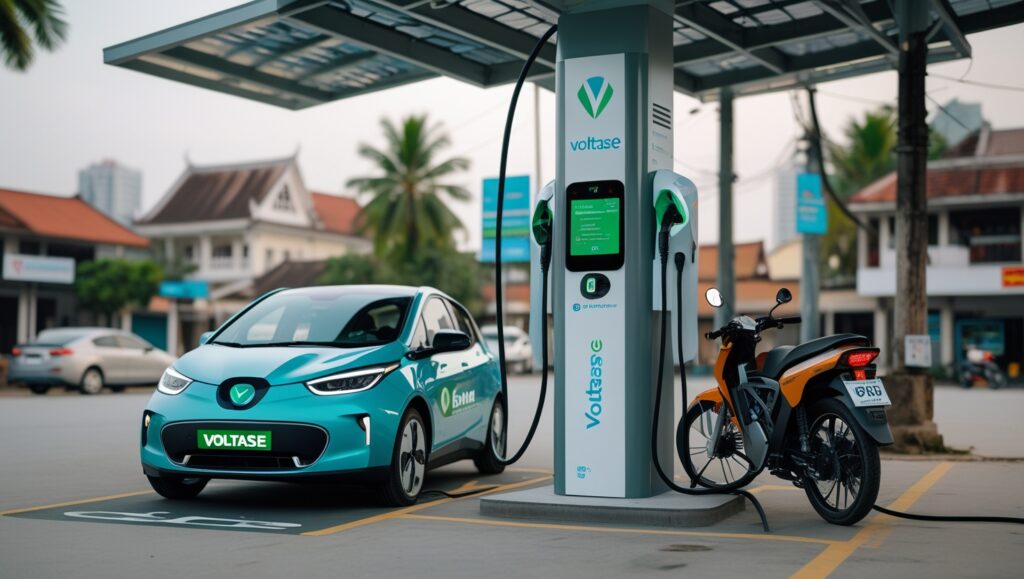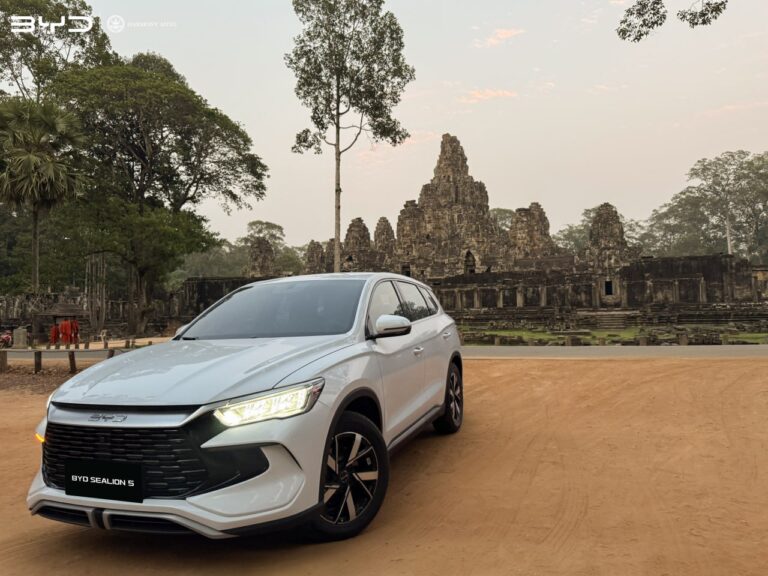The Green Revolution on Wheels: How EVs Are Reshaping Cambodia’s Energy Landscape

The Green Revolution on Wheels: How EVs Are Reshaping Cambodia’s Energy Landscape
Cambodia, a nation characterized by its dynamic economic growth and a burgeoning young population, is increasingly making strides towards sustainable development. This commitment is particularly evident in its evolving transport sector, where the hum of traditional combustion engines is gradually being joined by the silent, efficient glide of electric vehicles. The rise of electric vehicles (EVs) in Cambodia is not merely a shift in transportation preference; it’s a profound transformation that is fundamentally altering the nation’s energy consumption patterns and driving an accelerating demand for greener power.
This article delves deep into this fascinating interplay. We will explore the remarkable growth trajectory of EV adoption in Cambodia, examine how this trend is intrinsically linked to the country’s rapidly evolving energy mix, shed light on the crucial development of EV charging infrastructure, and analyze the pivotal policy frameworks supporting this green transition. Ultimately, we will showcase how EVs are not just a mode of transport but a powerful force propelling Cambodia towards a more sustainable and environmentally friendly energy future.
- The Green Revolution on Wheels: How EVs Are Reshaping Cambodia’s Energy Landscape
- The Silent Surge: Understanding EV Adoption Trends in Cambodia
- Fueling the Future: Cambodia’s Evolving Energy Mix and Green Commitment
- Plugging In: The Development of EV Charging Infrastructure in Cambodia
- Driving Change: Policy, Incentives, and Their Impact on EV Adoption
- The Dual Benefit: EVs’ Impact on Energy Consumption and the Environment
- Conclusion: Paving the Way for Cambodia’s Sustainable Mobility Future
- Frequently Asked Questions (FAQs) About EVs and Green Energy in Cambodia
The Silent Surge: Understanding EV Adoption Trends in Cambodia
Just a few years ago, electric vehicles in Cambodia were a rare sight, largely confined to niche enthusiasts. Today, however, the landscape is dramatically different. Cambodia is witnessing a silent but significant surge in EV adoption, reflecting a growing global trend towards cleaner mobility.
Official data from the Ministry of Public Works and Transport reveals a remarkable growth trajectory. From under 100 registered EVs in 2020, the numbers surged to over 1,000 by 2022. Projections indicate that registrations are set to reach several thousand by the end of 2024, demonstrating rapid expansion. This electric vehicle growth in Cambodia is particularly prominent in the two-wheel segment, with electric motorcycles making up a substantial portion of the registered EVs. Their affordability, lower running costs, and suitability for urban transport needs have made them an attractive option for a broad segment of the population.
This surge is not accidental. Several factors are fueling the adoption: escalating fuel prices, a rising awareness of environmental issues among the Cambodian populace, and an evolving consumer preference for modern, efficient, and quieter modes of transport. As an energy sector analyst in Phnom Penh aptly notes, “The rapid adoption of electric motorcycles signifies a grassroots shift towards cleaner transport, driven by economic benefits and increasing environmental awareness among the Cambodian public.” This grassroots movement is laying the groundwork for a broader transition across all vehicle types.

Fueling the Future: Cambodia’s Evolving Energy Mix and Green Commitment
The accelerating adoption of EVs in Cambodia is inextricably linked to the nation’s evolving energy mix. Historically, Cambodia’s electricity generation has relied heavily on a combination of hydropower and, to a lesser extent, coal. However, in recent years, there has been a concerted and strategic push towards Cambodia green energy sources, particularly solar power.
According to reports from the Ministry of Mines and Energy and Electricité du Cambodge (EDC), while hydropower still accounts for a significant portion (around 40-50%) and coal contributes roughly 30-40%, solar photovoltaic (PV) capacity is rapidly expanding. Solar PV is now contributing an impressive 10-15% of the national generation capacity as of 2023/2024, a figure that continues to grow. This shift is in line with the Cambodian government’s ambitious targets to increase renewable energy to 70% of its energy mix by 2030, a clear signal of its commitment to a sustainable power future.
This commitment places Cambodia in a unique position regarding EV adoption. As an official from the Ministry of Mines and Energy highlighted, “Cambodia is uniquely positioned. Unlike some nations still heavily reliant on fossil fuels for electricity, our growing solar capacity means that charging an EV here increasingly means charging with clean energy.” This direct correlation between EV charging and sustainable power for EVs from renewable sources amplifies the environmental benefits of electric mobility in the Kingdom, making the transition to EVs even more impactful.

Plugging In: The Development of EV Charging Infrastructure in Cambodia
For the EV adoption in Cambodia to truly flourish, a robust and accessible EV charging infrastructure is paramount. While initial developments were modest, primarily concentrated in key urban centers like Phnom Penh, the landscape is rapidly evolving.
The initial phase saw limited public charging stations, mostly operated by premium EV brands for their customers (e.g., Porsche, MG dealerships). However, significant expansion initiatives are now underway. Partnerships between EDC, private companies like Voltase, and major petrol station chains such as TotalEnergies and Caltex are gradually expanding the public charging network across the country. These collaborations are crucial for building confidence among potential EV owners, alleviating “range anxiety”—the” fear of running out of battery before reaching a charging point.
Currently, home charging remains the primary method for most EV owners in Cambodia. This underscores the importance of continued development in smart home charging solutions and grid stability. As a representative from a leading EV importer emphasized, “Expanding the charging infrastructure is key. While home charging covers daily needs, a robust public network, especially with fast chargers, will build consumer confidence for longer journeys and commercial fleet adoption.” The focus is now on strategically placing chargers in high-traffic areas and along key national roads to support interprovincial travel.

Driving Change: Policy, Incentives, and Their Impact on EV Adoption
The Cambodian government has played a pivotal role in accelerating the EV adoption in Cambodia through forward-thinking EV policy and substantial incentives. Recognizing the environmental and economic benefits, policymakers have actively created an enabling environment for electric mobility.
One of the most impactful measures has been the significant reduction in import duties for EVs. For electric cars, the import tax has been slashed from 30% to a mere 10%, making them more competitive with traditional gasoline vehicles. Even more impressively, import duties for electric motorcycles have been reduced to 0%, directly encouraging their mass adoption. These Cambodia government EV incentives directly address the common barrier of high upfront cost for EVs.
Beyond tax reductions, the government is also working on a broader national EV strategy. This includes developing clear regulatory frameworks for charging standards, ensuring interoperability between different charging networks, and planning for the long-term management of EV batteries, including recycling initiatives. As a policy analyst from UNDP Cambodia noted, “The government’s supportive policies, especially tax incentives, are crucial initial drivers. The next phase will focus on regulatory frameworks for charging standards, battery recycling, and grid integration.” These comprehensive efforts signal a strong commitment to building a sustainable EV ecosystem.

The Dual Benefit: EVs’ Impact on Energy Consumption and the Environment
The rise of EVs in Cambodia creates a fascinating dynamic with the nation’s energy consumption. As more electric vehicles hit the roads, there will naturally be an increased electricity demand on Cambodia’s national grid. However, projections from EDC indicate that this increase is manageable and factored into the country’s ongoing grid expansion plans and ambitious renewable energy projects.
Crucially, this new demand can be leveraged to optimize grid usage and absorb more clean energy. For instance, smart charging solutions can encourage EV owners to charge their vehicles during off-peak hours when electricity is often cheaper and when solar power generation is abundant. This strategic utilization helps balance the grid load and maximizes the consumption of renewable energy.
The environmental gains are substantial. EVs produce zero tailpipe emissions, leading to significantly reduced urban air pollution, a critical benefit for the health of city dwellers. As Cambodia’s grid becomes greener, the overall carbon emissions associated with transportation will also decrease. Furthermore, a shift to EVs reduces Cambodia’s reliance on imported fossil fuels, bolstering its energy security and contributing to long-term economic stability. A senior engineer from Electricité du Cambodge (EDC) aptly summarized this synergy: “While EV growth will certainly add to electricity demand, it’s a manageable increase. Crucially, as our renewable energy capacity expands, this new demand helps utilize clean power more effectively, reducing reliance on traditional sources.”
Conclusion: Paving the Way for Cambodia’s Sustainable Mobility Future
The advent of electric vehicles in Cambodia marks a pivotal moment in the nation’s journey towards sustainable development. These modern modes of transport are fundamentally reshaping Cambodia’s energy consumption patterns, driving an undeniable demand for clean, renewable energy sources, and delivering tangible environmental benefits to the kingdom. The synergy between rapid EV adoption and Cambodia’s ambitious green energy targets positions the nation at the forefront of a truly green transport revolution.
From the silent surge of electric motorcycles to the expanding network of charging stations and the supportive government policies, Cambodia is building a robust ecosystem for electric mobility. This is not just about cleaner air; it’s about enhancing energy security, reducing operational costs for consumers, and attracting green investment.
We strongly encourage individuals, businesses, and policymakers to continue their support for and investment in EV technology and green charging infrastructure. By embracing this green revolution on wheels, Cambodia can accelerate its transition to sustainable mobility, build a resilient energy future, and become a regional leader in environmental stewardship. The road ahead is electric, and Cambodia is charging forward.
Frequently Asked Questions (FAQs) About EVs and Green Energy in Cambodia
- Q: How many EVs are currently on Cambodia’s roads?
- A: While precise real-time numbers vary, registrations have seen a rapid increase from under 100 in 2020 to over 1,000 by 2022, with projections for several thousand by the end of 2024, largely driven by electric motorcycles.
- Q: What sources of energy are used to charge EVs in Cambodia?
- A: EVs in Cambodia primarily charge from the national grid. With Cambodia’s increasing reliance on renewable energy sources like hydropower and a rapidly growing solar PV capacity (10-15% by 2023/2024), charging an EV here increasingly means using clean energy.
- Q: Where can I find EV charging stations in Cambodia?
- A: Public EV charging stations are still expanding, primarily concentrated in Phnom Penh. Partnerships between EDC, private companies (like Voltase, Porsche, and MG), and petrol stations (TotalEnergies and Caltex) are growing the network, with more planned across key routes.
- Q: What government incentives are available for buying an EV in Cambodia?
- A: The Cambodian government offers significant tax incentives, including a reduced import tax of 10% for electric cars (down from 30%) and 0% for electric motorcycles, making EVs more affordable.
- Q: How do EVs contribute to cleaner air in Cambodian cities?
- A: EVs produce zero tailpipe emissions, directly reducing local air pollutants that contribute to smog and respiratory issues in urban areas. This significantly improves urban air quality and public health.



